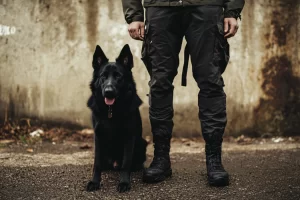Socializing Your German Shepherd Puppy: Part II
When your new German Shepherd puppy to new people, prepare these new people ahead of time to ignore the puppy. We mean that literally. As you are increasing your engagement with your puppy (if you are not familiar with this term, go and read part one to this series). As you introduce strangers to your puppy, instruct them ahead of time to ignore the puppy, to not speak to, touch, or look at the puppy. In this process you will have prepared the people ahead of time how to respond when near the puppy. As new people come into the room, work to keep your puppy entirely engaged, making use of high value treats. The puppy’s engagement is with you and you alone.
When it finally is time for you to go out in public, as the puppy’s owner, it’s your responsibility to let people know the puppy is off limits. Many people will be inclined to ignore your request and try to pet your puppy anyway. When that happens, be firm and serious. A true friend will respect your wishes in such a simple matter. As for strangers, if need be, ask them to take a step back.
Many new German Shepherd puppy owners feel uncomfortable being assertive. This is understandable. It can seem rude. But here is the risk if you do not stand your ground. If too many people invade the puppy’s space, your GSD puppy may develop a fear of strangers. Being fearful the puppy will bark. When strangers back off, the puppy learns that barking or showing aggression gets them what they want—to be left alone. Such an action, when reinforced can lead to the GSD developing aggression habits, something you will not want.
It’s much simpler to tell persistent people to not touch the puppy, and for that matter, to just leave it alone. It may help to remember, anyone who ignores your clear instructions probably wouldn’t make a good friend anyway. You are in charge, the puppy is not. During those early days of training, its your responsibility to give your German Shepherd puppy the best chance for success.
Your Best Plan of Action for Introducing Strangers to your German Shepherd Puppy
When you’re dealing with strangers around your puppy, is to keep your bag of high value treats handy. If your puppy seems a offput by someone, your job is to regain its attention. Engage the puppy. You are the puppy’s whole world. With the same reminder as Part I in this series, by high value treats, we don’t mean dry dog biscuits, but something which your puppy really responds to, something like pieces of bacon or chunks of meat. Your goal is to be more interesting to your puppy than the stranger. If the treat is good enough, your puppy will start to see strangers as a signal that fun and treats from you are coming. For you puppy to turn to you when strangers approach is not a problem. This shows he is learning and you are his focus.
Introducing Your GSD puppy to New Situations
The same strategy works in new places that might scare your puppy a bit. If you notice your puppy is feeling uneasy, engage your puppy with treats. This helps your puppy learn that new and scary places aren’t so bad because they mean time with you and delicious treats. Remember, your goal is that new people, sounds and situations will be of little interest to your puppy. As your German Shepherd puppy responds to training, these new situations will more and more be received with a degree of indifference. You puppy will increasingly learn that you are the source of fun and interest in its world.
Should You Allow Strangers To Give Your Puppy Treats
In short, absolutely not! Do you want to train your puppy to ignore you around strangers? Allowing other people to feed your dog, to engage with your dog is teaching your puppy that in these contexts, that you are the distraction. This is NOT something you want to do. And to make matters worse, if you dogs is already struggling with nervousness around strangers, once the treat is gone, if the strangers keep getting in their space and especially if trying to touch them, the dog will bark and even try and bite. Having strangers feed your dog will often compound any fear your German Shepherd puppy may be feeling. Don’t do it.
Introducing Your Dog to Other Dogs
It’s fine for your dog to have canine friends, but it’s essential to teach your puppy good manners. You do this by setting the stage for your young puppy on who and how your puppy interacts with other dogs. The first step begins with introducing your German Shepherd puppy to other dogs. The ideal candidate will be an adult dog that will more or less ignore you puppy. A dog that tends to be indifferent or aloof toward other dogs. Ideally, you want an adult dog that ignores your puppy rather than one that is overly playful or rough. As you introduce the two, keep your puppy on a leash. Keep your back of high value treats handy. keep showing your puppy that you are the highest value person in its life.
You want the older dog to be calm as this older dog will serve as a role model. Keep your puppy on a long leash. This allows you to maintain control while working on engagement exercises. The length of the leash can help manage your puppy’s movements and interactions.
The ideal adult dog for this kind of socialization is one that can correct your puppy’s inappropriate behavior in a gentle but firm manner without causing harm. This is crucial because it teaches your puppy boundaries and respect for other dogs. However, this kind of socialization should occur under close supervision. Close supervision is necessary to ensure the safety and well-being of both dogs. If your dogs is the puppy, then the puppy will obviously be the prime concern.
This socialization process should ideally take place before your puppy reaches 8 to 10 months of age. The first months of your puppy’s life are critical for developing social skills. With consistent and supervised interactions, your puppy can learn to behave appropriately around other dogs, making future playdates and social encounters more enjoyable and stress-free.
If a strange dog approaches, you are the pack leader. It is your responsibility to protect your dog. You won’t want your dog needing to learn dog aggression to protect itself. You stand between your dog and the approaching dog. Some trainers will recommend starting the practice of walking with a walking stick. Such a stick gives you a measure of motivation should the strange dog not heed your instructions to leave. Yes, you might find that dog’s owner upset with you, but better this than having to pry someone’s Pitt Bull (or some other dog) from your puppy. For context, its worth reminding that this article is being written for owners of a German Shepherd puppy. Many of you will be training your puppy as it matures into adulthood in protection training. You won’t want a dog aggressive prospect. And you want your dog to trust you implicitly. Don’t put your puppy in a position to develop shallow nerves. Thank you for taking the time to work through this information. Here at Czech Working Line we enjoy helping new German Shepherd Dog owners. We’ll be posting further on this topic in the near future.




